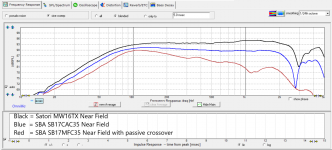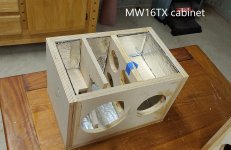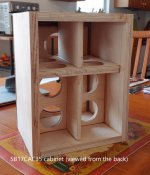Having an angled brace for the mid to woofer would help with internal standing waves also correct? Seems like most commercial speakers I’ve taken apart that focus on slim baffles have the drivers right up on the sidewalls (90 degrees).
A cone does not need to be "magically opaque" to sound waves. The energy radiated into the cabinet is exactly the same as the energy radiated to space. Naturally some of the internal cabinet sound is transmitted through the cone, just as it is also transmitted through the cabinet walls. The sound coming out of the cabinet is not corrupted or "un-pure". Unless there is an acoustical resonance (uncontrolled standing wave), there is not difference between the sound inside and outside the cabinet. Acoustical resonance is easy to control with acoustical damping.
j.
It is "unpure", in that there are multiple reflections from walls which are relatively close. You're implying they don't matter?
And the less room for the damping material. Acoustic damping is easier said than done. For instance, polyester fill is next to useless.
If internal cabinet energy radiates back through the cone in a way which is detrimental, it should be easily measurable with a near field measurement of the woofer or mid driver. Others have said it is visible with empty undamped boxes, and I am sure it is. But with a reasonably damped box, I have never seen any evidence of reflection, echo, or time smearing.
Shown in the first pic is near field responses of 3 different 6 inch drivers in 3 different cabinets. A polycone woofer, an aluminum/ceramic cone, and a carbon epoxy cone. All 3 cabinets are simple box shapes, with lots of reflective surfaces near the woofers, and everything is built with 90 degree angles. All 3 cabinets were loosely filled with fibrous damping material. Other than being very structurally stiff, these cabinets are very conventional.
I just do not see evidence of badness...
Shown in the first pic is near field responses of 3 different 6 inch drivers in 3 different cabinets. A polycone woofer, an aluminum/ceramic cone, and a carbon epoxy cone. All 3 cabinets are simple box shapes, with lots of reflective surfaces near the woofers, and everything is built with 90 degree angles. All 3 cabinets were loosely filled with fibrous damping material. Other than being very structurally stiff, these cabinets are very conventional.
I just do not see evidence of badness...
Attachments
I just do not see evidence of badness...
Those look very, very smooth. But they don't look anything like published frequency responses from the manufacturers or hificompass.
Maybe the frequency sweep was a bit too fast. My suggestion would be to try it a lot slower, and an impedance plot would be very illuminating too.
What Jim says about the rear radiation being OK provided it doesn't get invested in standing waves, is good. To see just what that would look like if the box did not produce them and was behaving like a single quantity spring effect, look at one of the closed box simulators. All the rear energy goes toward manipulating the main resonance. This goes on over a wide band, even though its significant effect is over a more narrow band.
Those look very, very smooth. But they don't look anything like published frequency responses from the manufacturers or hificompass
Most OEM published curves are far field anechoic. Most of the driver review sites, such as the excellent hificompass site, show gated far field responses, which are quasi-anechoic. These response curves always have a certain amount of "fuzziness" to them, mine included.
Near field responses, which is measured with the mic about 7 mm from the cone, look different. They are ideal infinite baffle responses and show no diffraction effects. They are typically very smooth, especially if the mic is well calibrated. OEM's and driver review sites rarely show near field responses. When they do show them, they are usually merged into the anechoic response at a few hundred Hz.
We recently had a good discussion thread on this very subject:
Midrange Enclosure Internal Shape
There was no conclusive agreement, but no one seemed to have any measurable evidence that the internal shape of a midrange enclosure had significance.
Now Keith, if you want to make the case that you can hear a difference when the driver is mounted close to a reflective surface, I will concede that. I believe there are aspects of the ear-brain interface that we do not understand, and there are aspects of reproduced sound that we do not yet know how to measure. If there is an audible difference, it is due to something more complicated than an internal reflection.
There are people on this site who can "hear a crossover", and they chose to only listen to full range drivers. They are hearing something I am not. There are others who only listen to open baffle systems because the "sound of the box" annoys them. Just because I do not hear what they hear does not mean it does not exist. I seem to be particularly sensitive to diaphragm resonances, and I have a strong preference for systems where the drivers are operated in their pistonic range... a lot of people love their paper drivers and soft dome tweeters, but not me.
jim
Driver manufacturer plots are intended to show the driver in half space. They are meant to be reasonably free of diffraction and reflection effects and as a result, the unique scope of the term 'far-field' is limited.
I think that some "enclosure" resonances are due to inadequate or carelessly applied fiber fill more than the enclosures actual shape. Chunks or blankets of fiber glass seem to be more "reflective" compared to other options available, eg. a more loosely applied fiber filler. Colored sound is more apparent to me with the former application vs a cleaner sounding bass/midrange with the latter ... in sealed enclosures.
What Jim says about the rear radiation being OK provided it doesn't get invested in standing waves, is good. To see just what that would look like if the box did not produce them and was behaving like a single quantity spring effect, look at one of the closed box simulators. All the rear energy goes toward manipulating the main resonance. This goes on over a wide band, even though its significant effect is over a more narrow band.
The cavity behind the driver will act as a lumped spring at low frequencies, but at higher frequencies, waves will propagate and be reflected off internal walls. Those emerging through the mostly transparent cone will add to or subtract from that emitted by the driver, depending on path length. How much, will depend on the amount of absorption through the cavity, and at the walls themselves (which should be lined).
Why should that not be the case?
Linkwitz: "I am of the opinion that the effect is most notable in the low hundreds of Hz region, where stuffing materials are ineffective and the internal dimensions not small enough for the internal air volume to act as a pure compliance" Frontiers
It seems highly unlikely that there would be time smearing issues?
It seems highly unlikely that there would be time smearing issues?
- Home
- Loudspeakers
- Multi-Way
- Drivers close to internal sidewall?



